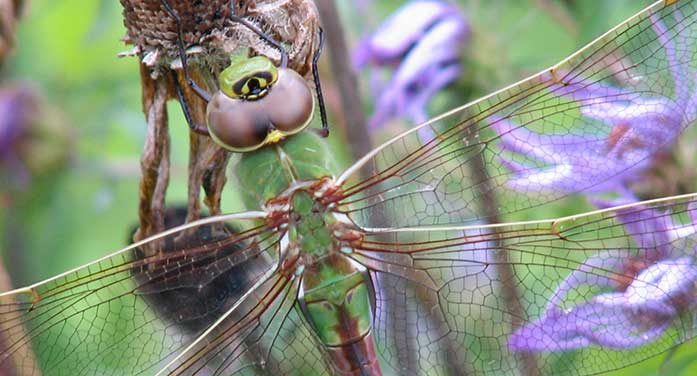 I know it’s still summer but soon it will get colder and things will be radically different. Sometimes I wonder where all the bugs go in the winter. Seems a bit silly but they’re out there somewhere all winter – at least most of them. But where are they?
I know it’s still summer but soon it will get colder and things will be radically different. Sometimes I wonder where all the bugs go in the winter. Seems a bit silly but they’re out there somewhere all winter – at least most of them. But where are they?
Insects and their allies (e.g. spiders, centipedes, thrips, ticks, etc.) all have to deal with the cold of winter when they’d assuredly die if they just presumed it was business as usual. So how do they survive?
The solutions are myriad and vary between species. Some, such as the monarch butterfly and the green darner (a type of dragonfly), undertake a long and dangerous migration to and from the south. Predators and hazards abound along the route.
Was it a wise choice? Presumably, since each year they return after having survived these adventures. Why they go and others stay is a mystery.
Most bugs do stay and figure out ways to survive the harsh conditions of winter. Hiding is the preferred option and it works well. But where when it’s cold out there?
Insects overwinter as adults, immatures or, in some cases, in the egg or pupal stage. Where they overwinter has to be carefully selected, ensuring that predators can’t find them and that there’s enough heat so they won’t freeze solid. It’s a risky business to be sure.

Cross Orbweaver spider
A few of the more adaptive ones have figured out that our homes are a good choice. Those of you living in the country are familiar with the cluster fly that seeks out our homes in the fall, where they try to hibernate. These are the ‘house flies’ we see on our windows each fall, clustering there.
Eventually they find tiny cracks in the walls and crawl behind them to overwinter. In the spring, they attempt to exit the house the same way they entered, but they have poor memories so often we see them on the window sill in March and April trying to get out through the glass.
Ladybugs and leaf-footed bugs are also happy to share our homes with us.
Others are even smarter and never actually leave the warmth of our homes. The cockroach, many ‘house’ spiders, white flies, fleas, bedbugs and house centipedes are but a few that have it figured out. So as long as they can find food, they’re okay since heat is no longer an issue. Life is good but most of us aren’t delighted to share our home with many of them as they can be a bit intrusive.
But if you see a spider in your home in the dead of winter, what’s it eating?
There must be food or it would die. What it eats are often harmful critters like silverfish, fleas, mites and, yes, bedbugs. So be tolerant of a winter spider – if it’s alive, its prey isn’t!
For the vast majority of insects, the outdoors is the only option. Masters at figuring out where the micro-climate is most ideal, they crawl under leaf litter, behind loose bark, bore into trees or tunnel underground. Some of the aquatic species will hide in the debris at the bottom of a pond or river or dig into the mud – carrying their own little pack of air in some cases or breathing through spiracles. Truly remarkable, insects can easily survive when outside temperatures dip well into the minus numbers.

Common Green Darner dragonfly
Insects reduce their biological functions so only essential processes work – respiration and waste elimination are basically all that operate in the winter. Obviously they don’t eat or breed, or even move about much, so energy loss is minimized and survival is better assured.
Whatever means they choose, it works, for each spring, they emerge and start the cycle again.
And because they stay here, other species can survive as well. Ever watch the chickadees and nuthatches searching tree bark, crevices around our houses or tossing leaves on the ground? It’s not idle exercise but a constant search for these billions of insect critters that will sustain the birds and mammals through the winter. The survival of the insects ensures the survival of many others.
So next time you see a bug in your house, respect her – she’s a smart one. By the way, it’s obviously a female since the males aren’t likely bright enough to come inside out of the cold – sorry guys!
Geoff Carpentier is a published author, expedition guide and environmental consultant. Visit Geoff online at www.avocetnatureservices.com, on LinkedIn and Facebook.
The views, opinions and positions expressed by columnists and contributors are the authors’ alone. They do not inherently or expressly reflect the views, opinions and/or positions of our publication. © Troy Media
Troy Media is an editorial content provider to media outlets and its own hosted community news outlets across Canada.



